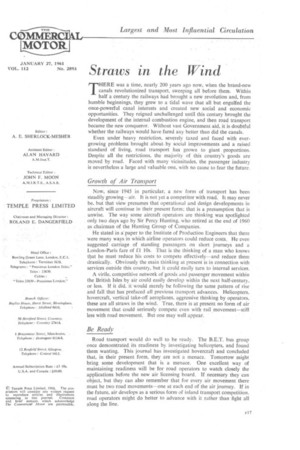Straws in the Wind
Page 25

If you've noticed an error in this article please click here to report it so we can fix it.
THERE was a time, nearly 200 years ago now, when the brand-new canals revolutionized transport, sweeping all before them. Within half a century the railways had brought a new revolution and, from humble beginnings, they grew to a tidal wave that all but engulfed the once-powerful canal interests and created new social and economic opportunities. They reigned unchallenged until this century brought the development of the internal combustion engine, and then road transport became the new conqueror. Without vast Government aid, it is doubtful whether the railways would have fared any better than did the canals.
Even under heavy restriction, severely taxed and faced with evergrowing problems brought about.by social improvements and a raised standard of living, road transport has grown to giant proportions. Despite all the restrictions, the majority of this country's goods are moved by road. Faced with many vicissitudes, the passenger industry is nevertheless a large and valuable one, with no cause to fear the future.
Growth of Air Transport Now, since .1945 in particular, a new form of transport has been steadily growing--air. It is not yet a competitor with road. It may never be, but that view presumes that operational and design developments in aircraft will continue in their present form; that is a presumption that is unwise. The way some aircraft operators are thinking was spotlighted only tWo days ago by Sir Percy Hunting, who retired at the end of 1960 as chairman of the Hunting Group of Companies.
He stated in a paper to the Institute of Production Engineers that there were-many ways in which airline operators could reduce costs. He even suggested carriage of standing passengers on short journeys and a London-Paris fare of fl 10s. That is the thinking of a man who knows that he mustreduce his costs to compete effectively—and reduce them drastically. Obviously the main thinking at present is in connection with services outside this country, but it could easily turn to internal services.
A virile, competitive network of goods and passenger movement within the British Isles by air could easily develop within the next half-century, or less. If it did, it would merely be following the same pattern of rise and fall that has prefaced all previous transport advances. Helicopters, hovercraft, vertical take-off aeroplanes, aggressive thinking by operators, these are all straws in the wind. True, there is at present no form of air movement that could seriously compete even with rail movement—still less with road movement. But one may well appear.
Be Ready
Road transport would do well to be ready. The B.E.T. bus group once demonstrated. its readiness by investigating helicopters, and found them wanting. This journal has investigated hovercraft and concluded that, in their present form, they are not a menace. Tomorrow might bring some development that is a menace. One excellent way of maintaining readiness will be for road operators to watch closely the applications before the new air licensing board. If necessary they can object, but they can also remember that for every air movement there must be two road movements—one at each end of the air journey. If in the future, air develops as a serious form of inland transport competition, road operators might do better to advance with it rather than fight all along the line.
















































































































